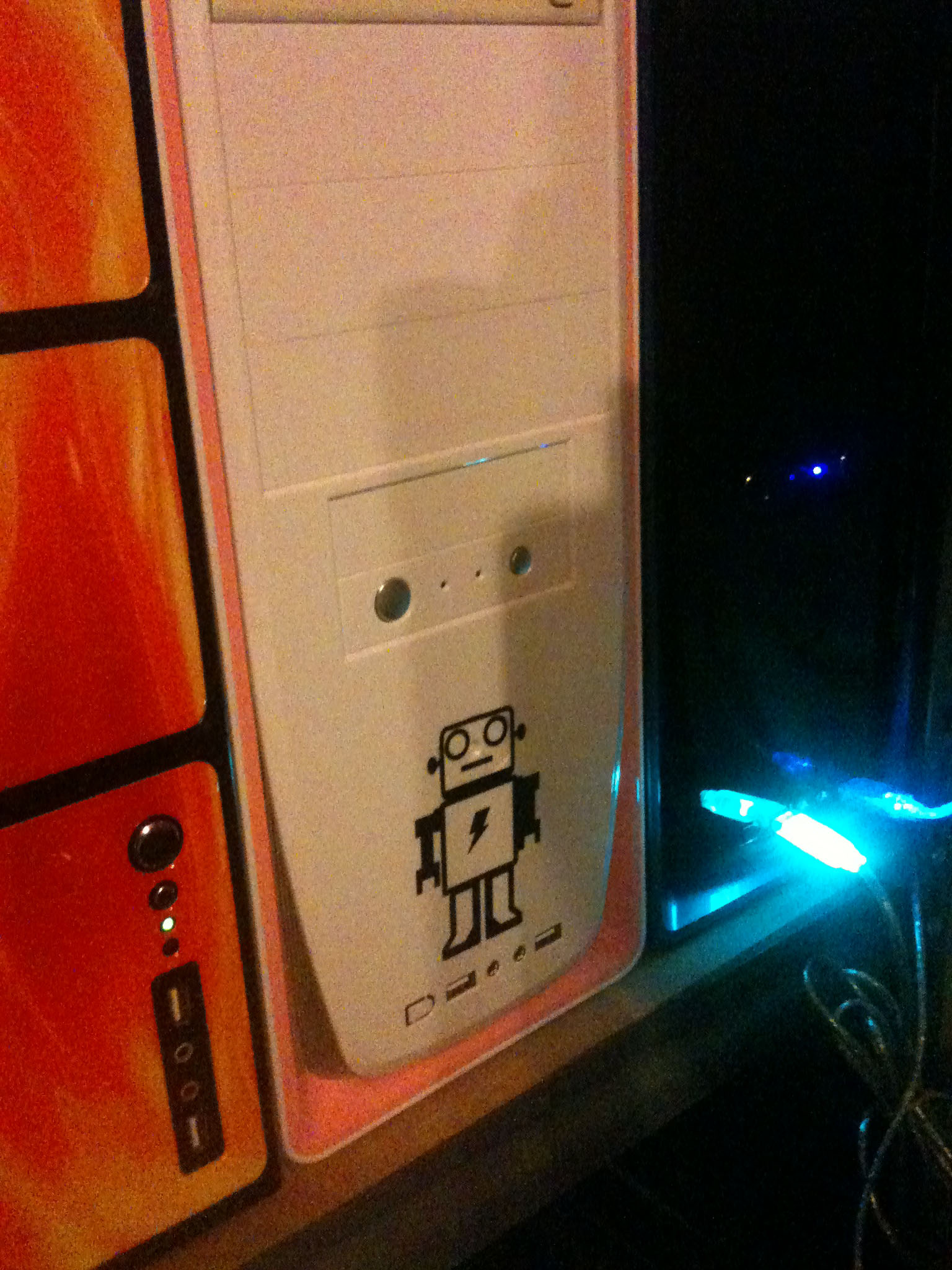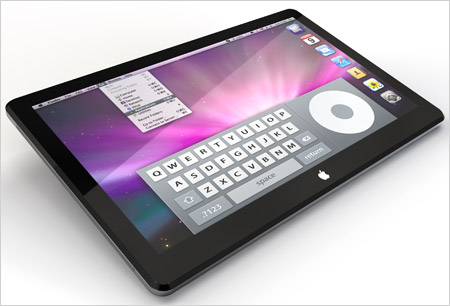…and some of his new friends.
(Photo by request)
…and some of his new friends.
(Photo by request)
Posted in Atomic Avenue, Geek Stuff
There’s a bug in the current build of SQL Server Express which prevents it from being installed on a Windows 7 machine (the pre-installation checks will fail on a “restart required” link. Restarting, obviously, doesn’t fix this.
The solution:
Go to Start > Cmd > RegEdit and navigate to the following key:
HKEY_LOCAL_MACHINE\SYSTEM\CurrentControlSet\Control\Session Manager
In the right-side pane, double-click on the key “PendingFileRenameOperations” and clear any values in there. Exit RegEdit.
Then, just re-run the SQL Express intaller and all should be fine.
Posted in Programming
We all knew Apple made pretty computers with great interfaces, but have they also managed to create the most power-efficient Windows server machine on the market?
[digg=http://digg.com/apple/Mac_Mini_The_World_s_Most_Power_Efficient_Server]
We just wrapped up a huge round of server upgrades at comicbase.com and AtomicAvenue.com. Last to go were our three oldest servers which we use to run a bunch of essential but boring jobs like our DNS, email, Microsoft Exchange, and Active Directory Domains.
The old servers were “1U” jobs–your basic short, wide, and very long boxes packed to the gills with heat-generating electronics. These were cooled–barely–by a suite of fans at the back of each box blowing at hurricane speeds.
Having these servers around the office was like having a cleaning woman permanently parked in the back room vacuuming up a storm. In fact, the noise of these servers was enough of a factor that finding a “server room” to put them in where they (a) wouldn’t overheat and (b) wouldn’t drive us all bonkers with their unceasing roar–was a major part of the search for our last two office locations.
So what replaced these power-sucking, heat-generating, noise-blasting behemoths? A trio of tiny Mac Minis running Windows Server 2008, thanks to Apple’s Boot Camp utility which lets you dual-boot them as either Windows or Mac OS X machines.
These are computers so diminutive that we can fit all three of them side by side on a single level of our server cabinet. They’re so quiet and power-efficient that they don’t even have (or need) fans to cool them. And the total power draw? About 57 watts total when they’re running full-out at their assigned jobs!
Now, I can’t recommend the Mac Mini for every server job. For one thing, their small, slow, laptop-style drives make them unsuitable for anything involving the storage of any great amount of data, or where disk speed enters the equation in any real way. For instance, they’d make pretty mediocre file servers or web servers, and fairly horrific database servers. They also lack a lot of server niceties like hot-swappable drives, redundant network adapters…or any of the other things which IT folks tend to gush over but rarely turn out to be useful in the real world.
But for jobs like DNS service, where the computer can load all the data it’ll ever need to serve in a small amount of its RAM, they seem (so far) to be working out as well as the buffest, most costly machine we could have thrown at the problem. Better yet, they’re doing it at a fairly trivial hardware cost, in near-perfect silence, and with a power draw hundreds of watts less than the servers they replaced.
I don’t know how Apple managed it, but I’m blown away that Apple–known everywhere for pretty interfaces and beautiful design–may have also created the world’s most energy-efficient server in the bargain. Well done, guys!
[digg=http://digg.com/apple/The_Apple_Tablet_and_The_Future_of_Comic_Books]
Noted comics writer James Hudnall writes in his blog that the rumored Apple Tablet (concept art shown below) could wind up saving the comic book industry. I agree that the Apple Tablet is going to be hugely disruptive to the print media world, for many of the reasons listed in another blog.

Here’s how I see the whole thing playing out: Sometime in January or February, Steve Jobs will get up on stage and announce the Apple Tablet. Essentially, it’ll looks like a big iPhone, complete with touch screen, glossy plastics, and impeccable industrial design. Wi-Fi is also a given, along with some sort of interface (Bluetooth?) which lets you set it in an equally impeccable cradle for charging, keyboard, and mouse access.
But the real win is going to be as a portable media “slate”–think HD movies, full-screen video conferencing, and the like…and then imagine reading a book on it.
This is where Jobs turns the demo over to little Johnny from Public School 323 somewhere. Johnny’s class will have been road-testing the Apple Tablet for their science textbooks, and he’ll hold up the tablet to the camera where it shows an elegant textbook cover which “opens” through the use of a gesture. Pages will be “riffled” similarly until Johnny arrives at some science diagram, perhaps showing the way an LED emits photons. Johnny will then tap the diagram with his finger, and it will come to life showing an animation depicting the whole process. Next will come history books showing famous speeches next to the picture of the speakers involved, recipe books showing video instruction for the dishes being cooked, etc.
And then–if I were Steve Jobs–I’d have Amazon’s Jeff Bezos come out on stage and announce that all those jillions of Kindle books which can already be read on your iPhone will also work on the Apple Tablet. Ditto for the Barnes and Noble book inventory.
So what about comics? Well, for a start it’s easy to imagine Marvel…err.. I mean Disney (of which Jobs is a board member and single largest stockholder) doing comics either specifically for the platform (a la Spider-Woman: Agent of S.W.O.R.D.) or simply making sure that the already-strong Marvel digital offerings include making it possible to buy any current (and possibly older) Marvel comic directly through the device at a fraction of the cost of buying it in paper form.
Although motion comics are expensive to produce, and still in their infancy in terms of technique, all modern comics are likely to pass through a digital “final” form (e.g. PDF) on the way to the printer anyway. Running it through a batch process to whip out the digital reader version is simplicity itself for the publishers.And if they sold the digital copy in a way which clears them a single dollar per copy, they’d already be more profitable to publish than the paper versions.
In this digital future, you’d lose the feel of paper and some of the other qualities (not least of all resalability) of the physical comic, but readers would also have them in pristine, archival format for an eternity without needing filing, comic boxes, or bags. And they’d cost a lot less–probably no more than $1 to $1.50 per issue.
Not everyone will go for it–at least not at first–but expect a larger and larger percentage of the comic buying audience to switch to digital in the same way that newspaper readers have. (And the month that an Australian reader can get their Marvels in this format for $0.99 instead of the $7.50 or more they currently pay, it’s all over on the newsstand).
At first, expect the readers–especially Apple’s–to be expensive enough that they appeal mostly to early adopters and those with fair amounts of spending money. But that’s not such a dissimilar demographic from the comic buying audience as a whole right now (comprised mostly of post-college males with higher than average family incomes). I think the digital future will be one us far faster than most would dream now.
To steal a surfing metaphor, a big wave is coming for the world of comics. You either gotta get on your board and ride it, or get prepared to go under.
[polldaddy poll=2151816]
It’s not often that I walk into a store, buy something, then feel guilty. But it happened to me again tonight.
Barnes and Noble is a favorite hangout for me and the kids, and we often browse there after grabbing a mocha in their in-store Starbucks. It’s a great way to spend an hour relaxing in pleasant surroundings, and I’ve definitely dropped a fair amount of cash there in the process.
But tonight, after I sipped a mocha from the B&N Starbucks and browsed through Tom Vanderbilt’s new book, “Traffic: Why We Drive the Way We Do (and What It Says About Us)“, I did something that’s become all-too frequent a habit of mine: I comparison shopped it on Amazon.com via my iPhone to see how the store price ($16 in paperback) stacked up. Given my Barnes & Noble membership card, my store price would have been $14.40 — but then the ridiculous Santa Clara County sales tax of 9.25% kicked in, raising it back up to $15.73 again.
In comparison, Amazon.com had it for $10.88, with no sales tax and free shipping (I also belong to their Amazon Prime program which gives me “Free” 2nd day shipping on most items for a yearly payment of about $70). “So,” I thought, “there’s my decision. Is getting it now vs. two days from now worth $4.85 to me?” And given how busy my schedule was, the answer was almost certainly, “No.”
But Barnes and Noble’s case got worse mere moments later when I realized that it existed in a Kindle edition for $9.99–I could be reading it in a minute or two, with no tax, shipping, or even a book to shelve or dispose of when it was all done with (I doubted I could recoup much or any of the cost by selling the paperback later).
“But wait!” I thought a moment later. “Here I am, sitting in this nice local store. Shouldn’t I occasionally spend $4.85 to help these guys out from time to time?”
A brief pause here to talk about my own personal shopper psychology: In our house, money spent on essentials and building for the future is OK–whether that means school for the kids, server upgrades for the business, or an appropriate business wardrobe for Carolyn (who just went back to work). On the other hand, things like books about traffic jam psychology, tin robots, Lego sets, etc. fall into the “luxuries” category, and there’s only so much of that I can do before the guilt kicks in pretty good. I love my non-essentials, but I can’t go nuts buying them. And I usually comparison shop.
So here’s my problem: I love Barnes and Noble, and if my $4.85 means the difference between keeping them around and not, I’m happy to spend it on them. But I also admire and respect Amazon.com. They run a great business, and the Kindle is a massively innovative (and disruptive!) piece of technology. The harsh reality is that if Barnes and Noble (or anyone else) wants a customer’s business, they have to get it by offering the superior value proposition–not just by appealing to the customer’s sense of guilt or charity.
But how does a physical book store–even a great one like Barnes and Noble–compete in a world where someone can get interested in a book by browsing it over a cup of coffee in the store, but buy it for less from a competitor before he even leaves the premises? Sometimes the physical properties of the book are enough–whether it’s color, binding, feel, etc. which can’t be easily copied digitally. But all-too-often, the simple answer is, “they can’t.”
So it’s with huge relief that I note that Barnes and Noble appears to be going on the offensive on their own, and engaging on the digital front in the war for readers with their own e-reader device designed to best the Amazon Kindle. If rumors are true, the device may even be revealed tomorrow, and it ups the ante by using twin screens (including a color, touch-sensitive one), and an aggressive price point. If they can also do battle on the content side, offering up similar offerings at similar prices, I’d be only too happy to jump on board. (Picture from Gizmodo).

(And yes, using the peculiar logic of geeks and small businessmen, it’s not a personal expense to buy a $259 e-reader if it turns out that we can also use it to view ComicBase reports. Then it’s an exploratory business development purchase, and comes out of the guilt-free “business” budget instead of the “luxuries” budget where a $259 purchase would cause me more than a little pause. Heck, look how I worried over $4.85 for a paperback!)
So bring it on, Barnes and Noble–I’m cheering for you.
And Amazon, I’m cheering for you too! Not to mention Apple, Microsoft, and anyone else who wants to engage in another round of the most amazing game in the world: Capitalism.
The rules are simple: You have to make something cool that people want more than they want to hold onto their money–i.e. you have to invent an entirely new thing, or beat the competition in some way that matters to the customer. And when the competition fights back with a new innovation of their own, you have to raise the stakes again with your own innovation, make your old thing more affordable, or quit the game. Force of any kind is considered cheating, especially when you attempt to get the government to use force on your behalf. Players can retire anytime they want, but the game itself never ends. And everyone wins except the quitters.
In memoriam…
Economist Joseph Schumpeter is famous for popularizing the term, “Creative Destruction” to talk about the way economic progress relentlessly grinds down the old to make way for the new in a never-ending cycle of “reinvent yourself or die”. For instance, buggy whip companies were driven out of business by Henry Ford’s horseless carriages which, being horseless, did not not need to be whipped quite as often. (They also pooped less). Similarly Polaroid had a monopoly on self-developing film but lost its business when digital cameras made film irrelevant, and suddenly you had other ways of taking pictures you didn’t want the photo developing guy to see.
For a little software company that’s been doing this ComicBase thing for seventeen years, we live and breathe this whole “creative destruction” thing ourselves–whether we like it or not. We started out shipping ComicBase on six compressed Mac OS 1.4 MB floppy disks, went on to become early adopters of CD, DVD, and digital video, and were the first PC program in the world to ship on Blu-ray Disc format. (We just made history again by being the first commercial PC program to ship on Dual-layer Blu-ray format!).
We’ve had to make the transition from Mac OS 7 to PowerPC processors, then wrote an entirely new version–in another language, no less–to let us run on PCs with Windows 95. Naturally, this led to later versions which in turn offered support for Windows 98, , Me*, 2000, NT, XP, and Vista, as well as new technologies like 64 bit operating systems and the growing use of mobile and handheld devices of all stripes.
*Which is to say that the constant glitches you experienced while using Windows Me were just the operating system blowing up, not ComicBase.
Ironically, we had to discontinue our original Macintosh version when Apple decided to mothball HyperCard, the development environment it was written in. Thankfully, Apple later introduced Intel-based machines which once again let the Mac folks use ComicBase under Windows, thanks to Apple’s Boot Camp software (and numerous other programs like VMWare, Parallels desktop and the like). It actually works so well that we even use a Mac Mini as one of our demo machines at San Diego Comic-Con–Not that I don’t still get regular hate mail from fans of the long-dead HyperCard version…
And of course, we’ve embraced the internet in a big way as well, starting with a basic HTML web site way back in 1996, and steadily revving it, rewriting it, and expanding it in the years that followed until it now does everything from real-time comic price quotes, to weekly price and title updates of the world’s largest comic book database. Then, since we clearly lacked anything else to do, we created Atomic Avenue–the vast online marketplace of comics which now boasts more comics for sale than all of eBay (1.2 million and counting!).
So what’s the point of this running travelogue through ComicBase history? In a roundabout way, it’s to explain why I treated five of our most loyal and longest-serving server machines to ignominious and painful deaths in the past week.
One by one they fell: “Spectrum” (our office file server) was repeatedly bashed and thrown onto the hard floor of our office until bits of plastic and metal came flying off from its horribly twisted case. “Judy” (backup and utility server), “Elroy” (our old production web server), and “Astro” (the production database server) had their disk drives ripped out, cards scavenged, then were mutilated and chucked into a dumpster parked behind our building.
And then there’s Goddard (our old test database server)…It’s probably best not to even talk about the things we did to him before the twisted bits that remained joined the bodies of Judy, Elroy, and Astro in the dumpster.
I feel really weird about all of this because in a big way, there was nothing wrong with those servers. They were all working absolutely fine when we sent them to that big shiny server rack in the sky. It’s just that their technology was getting too old, and it became possible to economically build new servers to replace them which offered twice the performance, were far quieter, and consumed less energy. We tried to find a nice retirement home to shove them off to via Craigslist and Facebook, but to no avail–they were heavy and cumbersome to ship, their technology was too specialized and dated to be worth selling, and nobody volunteered to adopt them before the time came for them to be put down.
So, after months of planning, machine construction, and staggered software installs to reconfigure all our interrelated sites and services to use the new machines, it became time for the old servers to be, well, creatively destroyed (at least, as creatively as we could be without the use of explosives!)
So long, fellas. I’ll sort of miss you when I browse my Network Neighborhood and don’t see your names there. At times like that, I’m sure I’ll think of the fun times and the pain we had together, and get all nostalgic for a second or two (except Judy–we never really bonded for some reason).
But rest assured: if we’re doing our job right, the day will come before too long, when your replacements will be blinking their little LEDs nervously as we assemble the machine that will replace them.
Like a lot of geeks, I spend a lot more time planning which bits of techno-kit to bring with me on a trip than worrying whether I’ve actually remembered to pack clothes or not. I gave it a good shot with my family’s two-week trip to Australia, but had a few misfires along the way. Here’s a brief rundown on what gadgets proved worth their travel weight down under, and which weren’t up to the task:
A crazy-cheap computer that’s light, has great battery life, a built-in camera for Skyping to the folks back home, and weighs next to nothing. If it weren’t for the slightly undersized keyboard and problematic positioning of the up-arrow key (net to the right Shift key), it’d be the perfect on-the-go computer. If you got an email from me during the past two weeks, it was likely sent from this sand-covered little netbook. I was also able to video-chat with my folks back in the states from one of the two hotel rooms that featured workable internet.
It’s been superseded the XSi (and higher-end models), but the shots from this 10.1 megapixel camera are light years ahead of the vacation snaps I took years ago–not to mention the pathetic camera phone shots we all sometimes have to make do with. It survived surf and sand with aplomb, and it’s the definitely my best tool to capture the beauty of a perfect beach or view.
This was a shocker to me, since my iPhone has become such a daily part of my life. I even congratulated myself on having the foresight to call ahead and set up a a global data roaming plan so that I’d get hit with a data charge of only $60 or so for the two weeks in Australia, vs. the several-hundred-dollar horror stories I’ve heard of from unwary travelers who dared to access the internet abroad without an international plan.
The truth is, I may as well have left it at home for all the good it did me. I burned through 1/3 of my allotted 50 MB of internet traffic within a day of arrival just trying to use it for basic hotel lookups and GPS navigation. Data speeds were almost useless even in the big cities (hosted by Vodafone locally), and GPS navigation was impossible due to slow response times and winding streets without turn-by-turn routing. Within a day, we’d made the decision to go back to the car rental place and pick up a ¨real¨ GPS (more on that in a moment).
Also, even with AT&T‘s pricey ¨Global Traveler¨ plan, we faced fees of well over a dollar a minute for calls, and more to pick up voice mails. And that was a discount from the regular roaming rates of over $3/minute(!). In the end, we wound up picking up a “burner” pre-paid phone in a mall for about $80 to give us the minimal mount of phone service we needed on the trip.
The truth is, without the internet and an affordable calling plan, the iPhone is hugely crippled. It was really a huge disappointment, although I did have one wonderful moment of joy with it at the end. I realized that you can actually type in non-map queries into Google Maps like “Comic Store, Brisbane, Australia” and have it instantly plot your location in the city next to every available comic store nearby–even with street view pictures of the shops. That was cool!
Thinking to save $59, I bowed out of simply buying the Australian maps for my own Tom Tom GPS, thinking I could just use the Google Maps on my iPhone. This was a disaster, and we quickly wound up heading around to the car hire place to pick up a rental Tom Tom for the duration of the trip.
Once it was up on our dash, it turned the trip instantly from a harried series of missed turns and frayed nerves into a relatively calm drive–albeit on what my American reflexes told me was the wrong side of the road. It also did a terrific job of pointing out gas, tourist attractions, and the numerous speed cameras that cover the Australian landscape.
If you’re planning to drive in Australia, do yourself a favor and bring this along–it would have been a far worse vacation without it.
Posted in Geek Stuff, Travel
A brief, and very incomplete list of things I discovered (usually the hard way) are important for Geeky Americans to know before travelling to Australia:
My best new idea for an invention: The Suncreen Shower Nozzle, which would mist you in a spray of SPF-30 right after you get done using the regular showerhead to wash the sand off from the day before. Expect to see me pitching it on a late night Aussie infomercial if this comic book thing doesn’t work out for me.


He’s sort of the Australian Billy the Kid, who did his own Maker Faire thing to create a bullet-proof outfit to do battle with the lawmen who were gunning for him. He’d make a great comic book character, and I love to think that if he lived today, he’d relax by paint-balling speed cameras.
All in all, an amazing country, and I’d love to go back. The sights are spectacular, and their beaches put ours to shame. Best of all, the people are some of the brightest, friendliest folks I’ve ever met, and they’ve got a terrific spirit which really made the trip a joy.